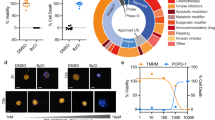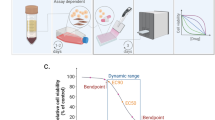Abstract
Selection of personalized chemotherapy regimen for individual patients has significant potential to improve chemotherapy efficacy and to reduce the deleterious effects of ineffective chemotherapy drugs. In this study, a rapid and high-throughput in vitro drug response assay was developed using a combination of microwell array and molecular imaging. The microwell array provided high-throughput analysis of drug response, which was quantified based on the reduction in intracellular uptake (2-[N-(7-nitrobenz-2-oxa-1,3-diazol-4-yl)amino]-2-deoxy-d-glucose) (2-NBDG). Using this synergistic approach, the drug response measurement was completed within 4 h, and only a couple thousand cells were needed for quantification. The broader application of this microwell molecular imaging approach was demonstrated by evaluating the drug response of two cancer cell lines, cervical (HeLa) and bladder (5637) cancer cells, to two distinct classes of chemotherapy drugs (cisplatin and paclitaxel). This approach did not require an extended cell culturing period, and the quantification of cellular drug response was 4–16 times faster compared with other cell-microarray drug response studies. Moreover, this molecular imaging approach had comparable sensitivity to traditional cell viability assays, i.e., the MTT assay and propidium iodide labeling of cellular nuclei;and similar throughput results as flow cytometry using only 1,000–2,000 cells. Given the simplicity and robustness of this microwell molecular imaging approach, it is anticipated that the assay can be adapted to quantify drug responses in a wide range of cancer cells and drugs and translated to clinical settings for a rapid in vitro drug response using clinically isolated samples.









Similar content being viewed by others
References
Johnstone RW, Ruefli AA, Lowe SW (2002) Apoptosis: a link between cancer genetics and chemotherapy. Cell 108:153–164
Kang HC, Kim I-J, Park J-H et al (2004) Identification of genes with differential expression in acquired drug-resistant gastric cancer cells using high-density oligonucleotide microarrays. Clin Cancer Res 10:272–284
Gottesman MM (2002) Mechanisms of cancer drug resistance. Annu Rev Med 53:615–627
Schrag D, Garewal HS, Burstein HJ et al (2004) American Society of Clinical Oncology Technology Assessment: chemotherapy sensitivity and resistance assays. J Clin Oncol 22:3631–3638
Samson DJ, Seidenfeld J, Ziegler K et al (2004) Chemotherapy sensitivity and resistance assays: a systematic review. J Clin Oncol 22:3618–3630
Burstein HJ, Mangu PB, Somerfield MR et al (2011) American Society of Clinical Oncology clinical practice guideline update on the use of chemotherapy sensitivity and resistance assays. J Clin Oncol 29:3328–3330
Meacham CE, Morrison SJ (2013) Tumour heterogeneity and cancer cell plasticity. Nature 501:328–337
Fernandes TG, Diogo MM, Clark DS et al (2009) High-throughput cellular microarray platforms: applications in drug discovery, toxicology and stem cell research. Trends Biotechnol 27:342–349
Russo G, Zegar C, Giordano A (2003) Advantages and limitations of microarray technology in human cancer. Oncogene 22:6497–6507
Meli L, Jordan ET, Clark DS et al. (2012) Influence of a three-dimensional, microarray environment on human cell culture in drug screening systems. Biomaterials
Chen P-C, Huang Y-Y, Juang J-L (2011) MEMS microwell and microcolumn arrays: novel methods for high-throughput cell-based assays. Lab Chip 11:3619–3625
Håkanson M, Kobel S, Lutolf MP et al (2012) Controlled breast cancer microarrays for the deconvolution of cellular multilayering and density effects upon drug responses. PloS ONE 7:e40141
Kwon CH, Wheeldon I, Kachouie NN et al (2011) Drug-eluting microarrays for cell-based screening of chemical-induced apoptosis. Anal Chem 83:4118–4125
Fletcher JW, Djulbegovic B, Soares HP et al (2008) Recommendations on the use of 18F-FDG PET in oncology. J Nucl Med 49:480–508
Hsu PP, Sabatini DM (2008) Cancer cell metabolism: Warburg and beyond. Cell 134:703–707
Vander Heiden MG, Cantley LC, Thompson CB (2009) Understanding the Warburg effect: the metabolic requirements of cell proliferation. Science 324:1029–1033
O’neil RG, Wu L, Mullani N (2005) Uptake of a fluorescent deoxyglucose analog (2-NBDG) in tumor cells. Mol Imaging Biol 7:388–392
Millon SR, Ostrander JH, Brown JQ et al (2011) Uptake of 2-NBDG as a method to monitor therapy response in breast cancer cell lines. Breast Cancer Res Treat 126:55–62
Siddik ZH (2003) Cisplatin: mode of cytotoxic action and molecular basis of resistance. Oncogene 22:7265–7279
Liebmann J, Cook J, Lipschultz C et al (1993) Cytotoxic studies of paclitaxel (Taxol) in human tumour cell lines. Br J Cancer 68:1104
Fuertes MA, Alonso C, Pérez JM (2003) Biochemical modulation of cisplatin mechanisms of action: enhancement of antitumor activity and circumvention of drug resistance. Chem Rev 103:645–662
Kumar N (1981) Taxol-induced polymerization of purified tubulin. Mechanism of action. J Biol Chem 256:10435–10441
Horwitz SB, Cohen D, Rao S et al. (1993) Taxol: mechanisms of action and resistance. Je Natl Cancer Inst. Monographs:55
Rettig JR, Folch A (2005) Large-scale single-cell trapping and imaging using microwell arrays. Anal Chem 77:5628–5634
Malinin TI, Perry VP (1967) Toxicity of dimethyl sulfoxide on HeLa cells. Cryobiology 4:90–96
Rassouli FB, Matin MM, Iranshahi M et al (2011) Investigating the enhancement of cisplatin cytotoxicity on 5637 cells by combination with mogoltacin. Toxicol In Vitro 25:469–474
Gibb RK, Taylor DD, Wan T et al (1997) Apoptosis as a measure of chemosensitivity to cisplatin and taxol therapy in ovarian cancer cell lines. Gynecol Oncol 65:13–22
Lamprecht MR, Sabatini DM, Carpenter AE (2007) Cell Profiler™: free, versatile software for automated biological image analysis. Biotechniques 42:71
Carmichael J, Mitchell J, Degraff W et al (1988) Chemosensitivity testing of human lung cancer cell lines using the MTT assay. Br J Cancer 57:540
Luo Z, Tikekar RV, Samadzadeh KM et al (2012) Optical molecular imaging approach for rapid assessment of response of individual cancer cells to chemotherapy. J Biomed Opt 17:1060061–1060068
Vitale M, Zamai L, Mazzotti G et al (1993) Differential kinetics of propidium iodide uptake in apoptotic and necrotic thymocytes. Histochemistry 100:223–229
Gillies RJ, Robey I, Gatenby RA (2008) Causes and consequences of increased glucose metabolism of cancers. J Nucl Med 49:24S–42S
Gatenby RA, Gillies RJ (2004) Why do cancers have high aerobic glycolysis? Nat Rev Cancer 4:891–899
Egawa-Takata T, Endo H, Fujita M et al (2010) Early reduction of glucose uptake after cisplatin treatment is a marker of cisplatin sensitivity in ovarian cancer. Cancer Sci 101:2171–2178
Bonfoco E, Krainc D, Ankarcrona M et al (1995) Apoptosis and necrosis: two distinct events induced, respectively, by mild and intense insults with N-methyl-D-aspartate or nitric oxide/superoxide in cortical cell cultures. Proc Natl Acad Sci 92:7162–7166
Acknowledgment
Support from the UC Cancer Research Coordinating Committee (3-440348-36240) is acknowledged.
Author information
Authors and Affiliations
Corresponding author
Electronic supplementary material
Below is the link to the electronic supplementary material.
ESM 1
(PDF 983 kb)
Rights and permissions
About this article
Cite this article
Wang, M.S., Luo, Z. & Nitin, N. Rapid assessment of drug response in cancer cells using microwell array and molecular imaging. Anal Bioanal Chem 406, 4195–4206 (2014). https://doi.org/10.1007/s00216-014-7759-y
Received:
Revised:
Accepted:
Published:
Issue Date:
DOI: https://doi.org/10.1007/s00216-014-7759-y




